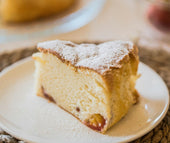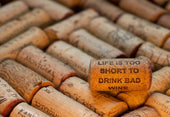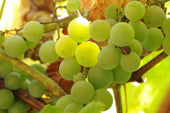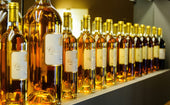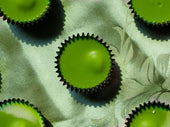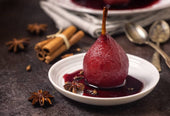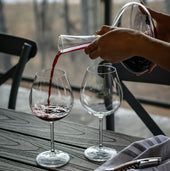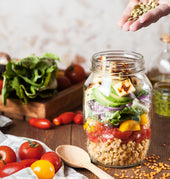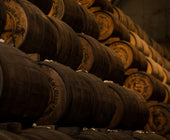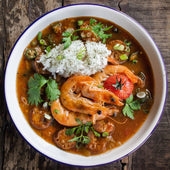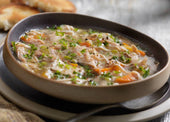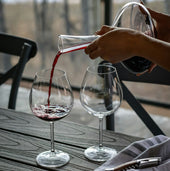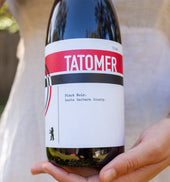
Message in your Bottle: What does the shape tell you?

Most wine drinkers know that wine bottle shapes are loosely related to the elixir inside, but the exact meaning behind that connection is rarely understood. Burgundy, Bordeaux or Alsace — the vessel shapes are familiar. How and why they became that way is less known.
In ancient times, wine was fermented and stored in earthenware jugs coated in beeswax, or in amphorae. As the Roman empire expanded and amphorae proved too delicate to bounce in wagons over good Roman roads, wooden wine barrels were used both for the making and transport of wine.
Thus it remained for millennia, until the beginning of the 17th century when the invention of the coal furnace allowed for the creation of sturdy glass vessels. Early glassware was used primarily for at-home wine storage. Hand blown glass had inconsistent volumes and customers wanted to know that they were getting all they paid for. It wasn’t until the early 1800’s that the revolution of bottle shapes took hold when the company Rickets of Bristol patented a machine that manufactured identically sized bottles, allowing wine to be transported and sold in glass rather than casks.
As diverse as modern wine bottle shapes are, they all have similar anatomical features. All bottles have a heel or base that holds it upright. Most have a punt or dimple on the bottom. (The punt’s purpose is oft-debated and multifold: to catch lees, to strengthen the bottle, to make the bottle look larger, to provide more surface area for cooling or to simply provide a handy thumbhole while pouring. For most wines today, it’s use is traditional or as an indication of quality.) The cylindrical part that contains the label is called the body. Bottles have shoulders that taper into the neck. At the top of the neck is the capsule—the material wrapping around the top of the neck and over the closure, which is how the bottle is sealed—often with a cork or a screwcap. The variations of these features separate one bottle shape from another.
There are four main bottle shapes: Alsace, Bordeaux, Burgundy and Champagne. The four shapes were developed in different regions to solve different challenges of winemaking, wine transportation, or both. At the time when bottles were becoming mainstream for wine storage and transport, there was less travel between these regions which may be a possible reason for the variety.
Burgundy
The oldest of the bottle shapes is the Burgundy bottle. Before Rickets of Bristol applied for their patent, France had one of the first glass factories in the middle of the 1700’s. The Burgundy bottle’s distinctive shape was easier for glassmakers to produce. Burgundy bottles are slightly pear-shaped with long-sloping shoulders and a shorter but larger body area. Both of the region's main varietals—Pinot Noir and Chardonnay—are sold in this bottle shape. It is used worldwide for those grapes, as well as other varietals that have similar flavor profiles. Notably, there’s much less room for a label on the Burgundy bottle. At the time of its inception, however, labels weren’t commonly used or considered.
Bordeaux
The Bordeaux shape was also developed in France. It owes its distinctive tall body and short-rounded shoulders to the aging of the region's red wines: Cabernet Sauvignon and Merlot (although it is also often used for Sauvignon Blanc.) The bottle’s shoulders were designed to catch sediment during the aging process. It’s thought that the sturdy shape was developed specifically for shipping over the ocean to England to assuage the British thirst for Claret.
Champagne:
The Champagne bottle shape is quite similar to the Burgundy shape (the regions are contiguous). It is made of stronger glass to withstand the internal pressure of the effervescent liquid. The deeper punt adds additional durability, but also aids in handling the bottle, especially during riddling, the process by which sediment resulting from the sparkling winemaking process is moved to the bottle’s neck for extraction before corking. An occasional variation in the Champagne bottle shape is a taper out from the heel which gives it a softer contour. The lip of the Champagne bottle is reinforced as well, to properly hold the basket which keeps its pressurized cork safely in place.
Alsace:
The Alsace or Germanic bottle owes its silhouette to the fact that, at its inception, German wine did not need to endure a roiling ocean voyage to reach the consumer but merely float gently down the Rhine River. It needed no punt to provide strength, and its long flute-like shape maximized dense packing. Thus, this tapering delicate shape, sometimes termed a drumstick, is instantly associated with Germanic varietals such as Riesling and Gewürztraminer.
In modern times, the shape of a bottle of wine is as much a marketing device as a tradition. Variations in bottle color, glass weight and punt size are other subtle signs to the knowledgeable about the relative quality of the liquid inside, even before they scry the cryptic information on the label. However, having knowledge of the basic bottle shapes is an excellent tool for interpreting the secrets contained in a bottle of wine.
 Patty Lyn Tweten is a writer, graphic designer and vineyard owner. She is also a devoted fan of rosés having helped her husband make their own with the sagniée method. Instagram Linkedin
Patty Lyn Tweten is a writer, graphic designer and vineyard owner. She is also a devoted fan of rosés having helped her husband make their own with the sagniée method. Instagram Linkedin







